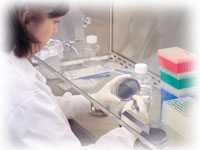Laboratory Information
On This Page
CDC’s Pertussis and Diphtheria Laboratory provides laboratory support to United States health departments requesting assistance with isolation, identification, and sub-typing of:
- Bordetella pertussis
- B. parapertussis
- B. holmesii
- B. bronchiseptica
- Corynebacterium diphtheriae
- C. ulcerans
- C. pseudotuberculosis
Pertactin-negative Pertussis Strains
In recent years, most pertussis strains in the United States are missing pertactin.
The laboratory serves as a resource and outbreak support for state and local health departments, domestic and international researchers, and other laboratory and hospital personnel. CDC is also actively involved with developing, evaluating, implementing, and improving molecular and serologic methods, techniques, and strategies. These efforts will enhance the diagnosis and surveillance of agents causing pertussis and diphtheria.
Despite a widespread childhood vaccination program, pertussis remains endemic in the United States. Confirming B. pertussis in the lab can be difficult and contributes to under-reporting of the disease. Problematic testing for B. pertussis can compromise prevention programs, surveillance activities, vaccine effectiveness studies, and outbreak management. CDC is currently researching methods to improve laboratory testing capabilities for B. pertussis. This includes spearheading a clinical validation study to ensure that validated laboratory assays are available to assess and manage pertussis cases and outbreaks. The clinical validation study will also help measure the real burden of pertussis disease. CDC is also actively researching new laboratory methods to better identify and characterize other Bordetella and Corynebacterium species. CDC actively participates in international capacity building and consultation for both pertussis and diphtheria diagnostics. In addition to reference activities, the laboratory is involved with domestic and international collaborative research projects that have direct public health relevance.
Reference Lab

The Pertussis and Diphtheria Laboratory can offer advice concerning laboratory procedures dealing with bacterial agents that cause pertussis and diphtheria such as:
- Isolation and identification of Bordetella and Corynebacterium organisms from clinical specimens
- Detection of organisms by polymerase chain reaction (PCR)
- Testing serum for antibodies to pertussis toxin.
CDC also performs characterization of B. pertussis isolates by serologic and molecular sub-typing methods for outbreak support and other public health concerns. Upon request, the laboratory can test for the presence of diphtheria toxin by the Elek assay for C. diphtheriae and C. ulcerans isolates. Together with Meningitis and Vaccine Preventable Diseases Branch epidemiologists, the Pertussis and Diphtheria Laboratory can assist health departments during pertussis outbreaks or when a case of diphtheria is suspected. CDC maintains extensive culture collections that span several years and geographical locations.
Laboratory testing will be provided only upon prior communication with the Pertussis and Diphtheria Laboratory indicating the reason for this service. If there is a pertussis outbreak or suspected diphtheria case that requires assistance please call the number listed below.
If you have questions that your local health department cannot answer, contact CDC by calling 1-800-CDC-INFO or submit a request online to be put in touch with the Meningitis and Vaccine Preventable Diseases Branch.
Surveillance Manual
The Manual for the Surveillance of Vaccine-Preventable Diseases provides current guidelines for those directly involved in surveillance of vaccine-preventable diseases, especially personnel at local health departments.
- Page last reviewed: August 7, 2017
- Page last updated: August 7, 2017
- Content source:


 ShareCompartir
ShareCompartir